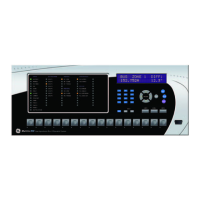5-162 B90 LOW IMPEDANCE BUS DIFFERENTIAL SYSTEM – INSTRUCTION MANUAL
GROUPED ELEMENTS CHAPTER 5: SETTINGS
5
5.6.4.2 Stage 1: Initiation
The breaker failure scheme is initiated by a FlexLogic operand representing the protection trip signal initially sent to the
breaker. This signal does not include other breaker commands that are not indicative of a fault in the protected zone. The
initiating signal should be sealed-in if primary fault detection can reset before the fault is cleared. The seal-in is supervised
by current level, so it resets when the fault is cleared. If desired, an incomplete sequence seal-in reset can be implemented
by using the initiating operand to also initiate a FlexLogic timer set longer than any breaker failure timer, whose output
operand is selected to block the breaker failure scheme.
Breaker failure scheme can be initiated either directly or with current level supervision. It is particularly important in any
application to decide if a current-supervised initiate is to be used. The use of a current supervised initiate results in the
breaker failure element not being initiate for a breaker that has very little or no current flowing through it, which may be
the case for transformer faults or ring bus where unequal current division between ring bus circuit breakers can delay the
failed breaker clearing time until the healthy ring breaker has operated. For those situations where it is required to
maintain breaker fail coverage for fault levels below the
BF1 AMP SUPV PICKUP setting, a current supervised initiate should
not be used. This feature should be used for those situations where coordinating margins can be reduced when high speed
reclosing is used. If this choice is made the current supervision pickup level must be lower than the minimum fault current
flowing through the breaker.
Immediately after scheme initiation it sends again a trip signal to the breaker (re-trip). This is intended to reduce the
possibility of widespread tripping that results from a declaration of a failed breaker.
5.6.4.3 Stage 2: Determination of a breaker failure condition
Improved flexibility is achieved by providing three timers or stages (Timers 1, 2, and 3) as shown in the Breaker Failure Logic
diagram. Each stage is individually enabled and asserts its individual operand.
Only a breaker auxiliary contact (fast-operating) or current supervision (if enabled) can reset Timer 1 (early stage). If Timer
1 expires, it implies that current is still flowing or the breaker (position status) is still closed; that is, the breaker failed to
open. The Timer 2 (main stage) logic is not supervised by breaker status, only by current. An output is issued if current is
detected after the Timer 2 delay interval. This stage detects the condition where a breaker opens mechanically but fails to
interrupt fault current.
The HISET and LOSET settings discriminate between the pre- and post-tripping current variation for breakers that employ
opening resistors. If the current level is between HISET and LOSET, a time delay (
BF x LOSET TIME DELAY) is added. For
currents above the HISET value, the
BFxx LOSET TIME DELAY timer is bypassed.
The
BF x LOSET TIME DELAY is based on the time that breaker resistor limited current can flow through the circuit after the
breaker interruption time. Both current detectors provide fast operating time for small multiples of the pickup setting.
The Timer 3 (slow stage) is supervised by breaker status (auxiliary contact) and control switch status, the latter indicating if
the breaker is in/out of service. This mode is typically used during maintenance. There is no current level check for this
stage since this is associated with small currents. Timer 3 is typically set with a longer time.
5.6.4.4 Stage 3: Output
The outputs from the scheme are:
• FlexLogic operands that report on the operation of portions of the scheme
• FlexLogic operand used to re-trip the protected breaker
• FlexLogic operands that initiate tripping required to clear the faulted zone. The trip output can be sealed-in for an
adjustable period.
• Target message indicating a failed breaker has been declared
• Illumination of the face plate TRIP LED
The Breaker Failure can be used with single-pole tripping schemes if the HISET and LOSET current elements are set
below the lowest expected fault current and above the highest expected load current.

